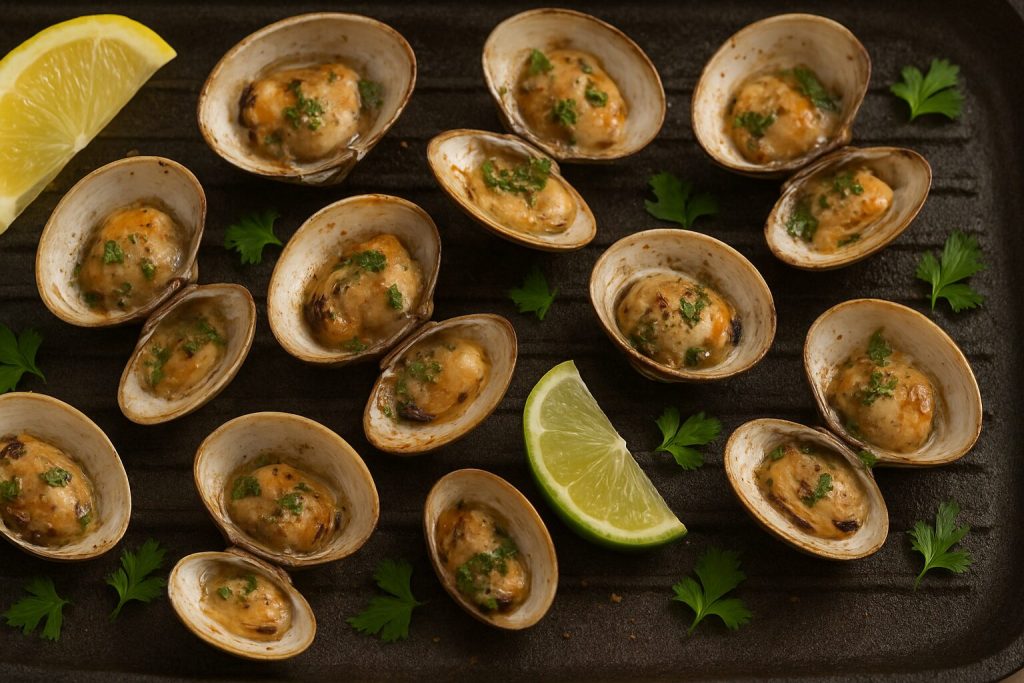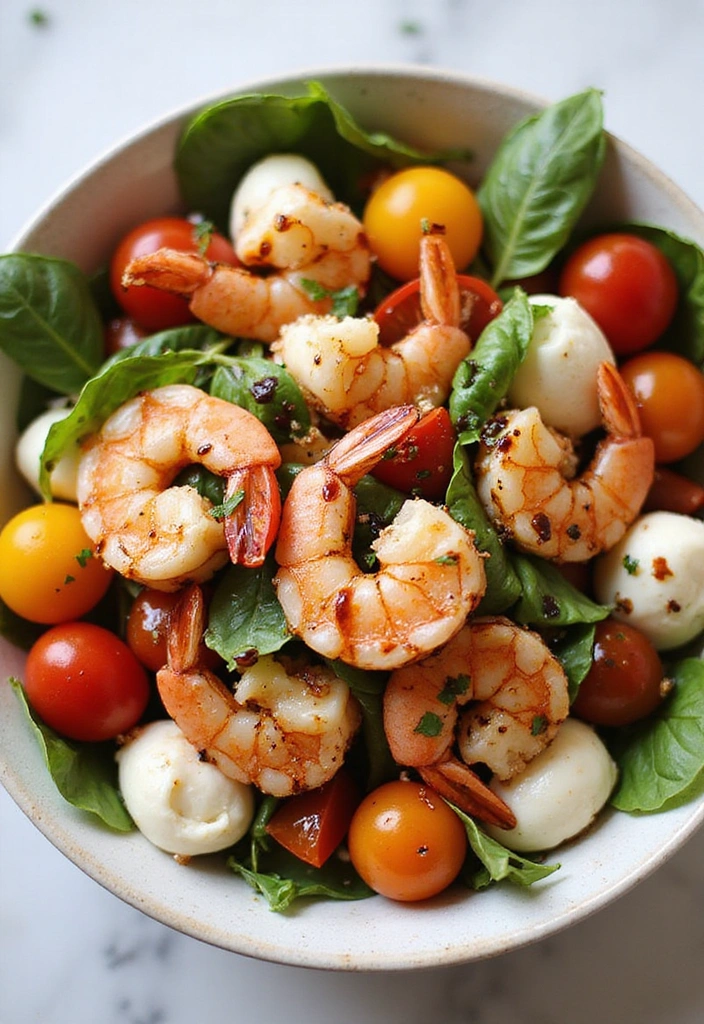The Best Fluffy Pancakes recipe you will fall in love with. Full of tips and tricks to help you make the best pancakes.
Seafood, which includes both fish and shellfish, is widely recognized as one of the most nutritionally dense food groups available. Incorporating it into your diet can provide a wealth of high-quality protein, healthy fats, vitamins, and minerals that are crucial for optimal health. Decades of scientific research have demonstrated that diets rich in seafood are linked to a lower risk of numerous health conditions and can play a vital role in physical and mental well-being.1Jillian Kubala, RD. (2021). Is Seafood Healthy? Types, Nutrition, Benefits, and Risks. https://www.healthline.com/nutrition/is-seafood-healthy

This guide explores the incredible nutritional benefits of seafood, breaking down the key nutrients it provides and the profound impact they have on your health.2Joe Leech, MS. (2025). 9 Evidence-Based Health Benefits of Eating Fish. https://www.healthline.com/nutrition/11-health-benefits-of-fish
To put what you get here into practice, check out this article on the Ultimate Guide to Safe and Delicious Shrimp and Vegetable Skewers
A Treasure Trove of Essential Nutrients
Seafood is a concentrated source of many nutrients that are often lacking in modern diets. Including it just a couple of times a week can help fill significant nutritional gaps.3Elizabeth K. Lund. (2013). Health benefits of seafood; Is it just the fatty acids? https://www.sciencedirect.com/science/article/abs/pii/S0308814613000575 And with a growing range of healthy seafood recipes available online, it’s easier than ever to prepare meals that are both delicious and nutrient-dense.
1. High-Quality, Lean Protein
Seafood is an excellent source of easily digestible, high-quality protein, which is essential for building and maintaining bones, muscles, and skin. A single 3.5-ounce serving of most fish or shellfish can provide nearly half of an adult’s daily protein needs for only 100 to 200 calories.4Elizabeth Reames. (2012). Nutritional Benefits of Seafood. Aquaculture. https://aquaculture.ca.uky.edu/sites/aquaculture.ca.uky.edu/files/srac_7300_nutritional_benefits_of_seafood.pdf Unlike some other animal proteins, seafood is also very low in saturated fat.5Louisa Richards. (2023). Should people with high cholesterol avoid eating fish? Medical News Today. https://www.medicalnewstoday.com/articles/323661
2. Omega-3 Fatty Acids: The “Heart-Healthy” Fats
Perhaps the most celebrated benefit of seafood is its high concentration of long-chain omega-3 fatty acids, specifically eicosapentaenoic acid (EPA) and docosahexaenoic acid (DHA). Our bodies cannot produce these essential fats efficiently, so we must get them from our food.6Danielle Swanson, et al. (2012). Omega-3 Fatty Acids EPA and DHA: Health Benefits Throughout Life. Advances in Nutrition. https://www.sciencedirect.com/science/article/pii/S2161831322009620 Omega-3s are critical for:
- Heart Health: They help lower blood pressure, reduce blood clotting, decrease triglycerides, and reduce the risk of strokes and heart failure.7National Heart Lung and Blood Institute. (2024). Omega-3s for heart health? Exploring potential benefits and risks. National Institute of Health. https://www.nhlbi.nih.gov/news/2024/omega-3s-heart-health-exploring-potential-benefits-and-risks
- Brain Function: DHA is a major structural component of the brain and retina. Adequate intake is linked to improved brain function, reduced risk of age-related mental decline, and may decrease the risk of depression and dementia.8Ibrahim M Dighriri, et al. (2022). Effects of Omega-3 Polyunsaturated Fatty Acids on Brain Functions: A Systematic Review. PubMedCentral. https://pmc.ncbi.nlm.nih.gov/articles/PMC9641984
- Infant Development: Omega-3s are vital for the development of the brain, nerves, and vision in infants, making seafood an important food for pregnant and breastfeeding women.9Sandra L Huffman, et al. (2011). Essential fats: how do they affect growth and development of infants and young children in developing countries? A literature review. PubMed. https://pubmed.ncbi.nlm.nih.gov/21929635
Top Sources of Omega-3s: Fatty, oily fish contain the highest levels. Excellent choices include salmon, mackerel, herring, sardines, anchovies, and sablefish (black cod).10SeaFood Nutrition Partnership. (2021). What Seafood Is Highest Omega-3s? https://www.seafoodnutrition.org/seafood-101/nutrition/what-seafood-is-highest-omega-3s If you don’t regularly consume seafood, you may want to consider a high-quality Omega-3 fish oil supplement like the Sports Research Triple Strength Omega 3 Burpless Fish Oil or opt for the Triple Strength 3600 mg Omega 3 Fish Oil (best deal).
3. Vitamin B12 and B-Complex Vitamins
Seafood is packed with B vitamins, which are crucial for energy production, brain function, and creating DNA.
- Vitamin B12: Many types of seafood are extraordinarily rich in vitamin B12. A single 3-ounce serving of cooked clams can provide over 3,500% of the Daily Value (DV). Seaweeds, mussels, nutritional yeast, and oysters are also exceptionally high in this nutrient, which supports nerve function and the formation of red blood cells.11Kathleen Felton. (2024). What Food Is Highest in Vitamin B12? Health. https://www.health.com/nutrition/vitamin-b12-foods
- Other B Vitamins: Seafood also supplies significant amounts of niacin (B3), vitamin B6, and riboflavin (B2), which help reduce fatigue and support psychological function.12Marsha McCulloch. (2023). 15 Healthy Foods High in B Vitamins. Healthline. https://www.healthline.com/nutrition/vitamin-b-foods
4. Vitamin D: The “Sunshine Vitamin”
Oily fish are one of the few natural dietary sources of vitamin D, a nutrient many people are deficient in. Vitamin D is essential for bone health because it helps the body absorb calcium and phosphorus.13Royal Osteoporosis Society (2022). Vitamin D for bones. https://theros.org.uk/information-and-support/bone-health/vitamin-d-for-bones Farmed whitefish and wild salmonids have been identified as being particularly rich in vitamin D, but wild salmonids generally have higher levels.14Z Lu. (2009). An Evaluation of the Vitamin D3 Content in Fish: Is the Vitamin D Content Adequate to Satisfy the Dietary Requirement for Vitamin D? PubMedCentral. https://pmc.ncbi.nlm.nih.gov/articles/PMC2698592

5. Essential Minerals
Seafood is a fantastic source of minerals that are vital for immune function, bone health, and metabolism.
- Selenium: An essential antioxidant that protects the body from damage and supports immune function and thyroid health. Tuna, salmon, and clams are excellent sources.15Jillian Kubala. (2023). 7 Science-Based Health Benefits of Selenium. Healthline. https://www.healthline.com/nutrition/selenium-benefits
- Iodine: Critical for thyroid hormone production, which regulates metabolism. Many people are deficient in iodine globally. Cod, haddock, and other marine fish are good sources of this nutrient.16MedlinePlus. (2023). Iodine in diet. National Library of Medicine. https://medlineplus.gov/ency/article/002421.htm
- Zinc: Supports immune function, wound healing, and skin health. Oysters are famously one of the richest sources of zinc, but clams and crab are also excellent choices.17Kathleen M. Zelman. (2024). Foods High in Zinc. WebMD. https://www.webmd.com/diet/foods-high-in-zinc
- Iron: Crucial for transporting oxygen in the blood and preventing anemia. Clams and oysters are particularly high in iron.18Fady Moustarah & Sharon F. Daley. (2024). Dietary Iron. National Library of Medicine. https://www.ncbi.nlm.nih.gov/books/NBK540969
- Calcium & Phosphorus: Fish consumed with bones, like canned sardines and salmon, are a great source of calcium and phosphorus, which are fundamental for building and maintaining strong bones.19Kerri-Ann Jennings. (2025). Top 15 Calcium-Rich Foods – Including Many Nondairy Options. Healthline. https://www.healthline.com/nutrition/15-calcium-rich-foods
For inspiration on how to prepare these nutritious options, check out our Top 10 Grilled Seafood Recipes.
Key Health Benefits of a Seafood-Rich Diet
The powerful combination of nutrients in seafood translates to profound health benefits.
| Health Area | Benefit | Key Nutrients Involved |
|---|---|---|
| Heart Health | Lowers blood pressure, reduces risk of heart attack and stroke. | Omega-3s (EPA & DHA) |
| Brain Health | Supports cognitive function, memory, and may reduce the risk of Alzheimer’s and dementia. | Omega-3s (DHA), Iodine, B Vitamins |
| Immune Support | Strengthens the body’s defenses against illness. | Zinc, Iron, Selenium, Vitamins B6, B12, D |
| Bone Strength | Helps maintain bone density and may reduce the risk of osteoporosis. | Protein, Phosphorus, Vitamin D, Calcium |
| Eye Health | Reduces risk of age-related macular degeneration and supports vision. | Omega-3s (DHA), Vitamin A |

Dietary Recommendations
Given the overwhelming evidence of its benefits, leading health organizations strongly recommend regular seafood consumption.
- The American Heart Association recommends eating at least two servings (about 8 ounces total) of seafood per week.
- It’s important to eat a variety of seafood to get a wide range of nutrients. This should include choices higher in omega-3s, such as salmon or sardines, as well as leaner fish like cod or tilapia.20The National Institutes of Health. (2022). Omega-3 Fatty Acids. US Department of Health and Human Services. https://ods.od.nih.gov/factsheets/Omega3FattyAcids-Consumer. These versatile options work beautifully in everything from light lunches to quick seafood dinner ideas the whole family will enjoy.
Making Smart Choices
Nutrient profiles can vary significantly between species. For instance, salmon and small pelagic fish like sardines are among the most nutrient-dense, while crustaceans and most whitefish tend to have lower nutrient density scores (though they are still excellent sources of lean protein).21Moenieba Isaacs. (2016). The humble sardine (small pelagics): fish as food or fodder. Agriculture & Food Security. https://agricultureandfoodsecurity.biomedcentral.com/articles/10.1186/s40066-016-0073-5. For more inspiration, explore our collection of healthy seafood recipes and quick dinner ideas, including our 10 Low-Calorie Shrimp Dish Ideas for Healthy Dinner.
Conclusion
The nutritional power of seafood is undeniable. As a rich source of high-quality protein, essential omega-3 fatty acids, and a unique spectrum of vitamins and minerals, it offers comprehensive benefits for nearly every aspect of human health. By incorporating a variety of fish and shellfish into your diet at least twice a week, you can take a delicious and proactive step toward supporting your heart, brain, and overall vitality. Whether you’re grilling salmon or experimenting with new healthy dinner recipes, seafood offers something for every palate and lifestyle.
List of Sources
- 1Jillian Kubala, RD. (2021). Is Seafood Healthy? Types, Nutrition, Benefits, and Risks. https://www.healthline.com/nutrition/is-seafood-healthy
- 2Joe Leech, MS. (2025). 9 Evidence-Based Health Benefits of Eating Fish. https://www.healthline.com/nutrition/11-health-benefits-of-fish
- 3Elizabeth K. Lund. (2013). Health benefits of seafood; Is it just the fatty acids? https://www.sciencedirect.com/science/article/abs/pii/S0308814613000575
- 4Elizabeth Reames. (2012). Nutritional Benefits of Seafood. Aquaculture. https://aquaculture.ca.uky.edu/sites/aquaculture.ca.uky.edu/files/srac_7300_nutritional_benefits_of_seafood.pdf
- 5Louisa Richards. (2023). Should people with high cholesterol avoid eating fish? Medical News Today. https://www.medicalnewstoday.com/articles/323661
- 6Danielle Swanson, et al. (2012). Omega-3 Fatty Acids EPA and DHA: Health Benefits Throughout Life. Advances in Nutrition. https://www.sciencedirect.com/science/article/pii/S2161831322009620
- 7National Heart Lung and Blood Institute. (2024). Omega-3s for heart health? Exploring potential benefits and risks. National Institute of Health. https://www.nhlbi.nih.gov/news/2024/omega-3s-heart-health-exploring-potential-benefits-and-risks
- 8Ibrahim M Dighriri, et al. (2022). Effects of Omega-3 Polyunsaturated Fatty Acids on Brain Functions: A Systematic Review. PubMedCentral. https://pmc.ncbi.nlm.nih.gov/articles/PMC9641984
- 9Sandra L Huffman, et al. (2011). Essential fats: how do they affect growth and development of infants and young children in developing countries? A literature review. PubMed. https://pubmed.ncbi.nlm.nih.gov/21929635
- 10SeaFood Nutrition Partnership. (2021). What Seafood Is Highest Omega-3s? https://www.seafoodnutrition.org/seafood-101/nutrition/what-seafood-is-highest-omega-3s
- 11Kathleen Felton. (2024). What Food Is Highest in Vitamin B12? Health. https://www.health.com/nutrition/vitamin-b12-foods
- 12Marsha McCulloch. (2023). 15 Healthy Foods High in B Vitamins. Healthline. https://www.healthline.com/nutrition/vitamin-b-foods
- 13Royal Osteoporosis Society (2022). Vitamin D for bones. https://theros.org.uk/information-and-support/bone-health/vitamin-d-for-bones
- 14Z Lu. (2009). An Evaluation of the Vitamin D3 Content in Fish: Is the Vitamin D Content Adequate to Satisfy the Dietary Requirement for Vitamin D? PubMedCentral. https://pmc.ncbi.nlm.nih.gov/articles/PMC2698592
- 15Jillian Kubala. (2023). 7 Science-Based Health Benefits of Selenium. Healthline. https://www.healthline.com/nutrition/selenium-benefits
- 16MedlinePlus. (2023). Iodine in diet. National Library of Medicine. https://medlineplus.gov/ency/article/002421.htm
- 17Kathleen M. Zelman. (2024). Foods High in Zinc. WebMD. https://www.webmd.com/diet/foods-high-in-zinc
- 18Fady Moustarah & Sharon F. Daley. (2024). Dietary Iron. National Library of Medicine. https://www.ncbi.nlm.nih.gov/books/NBK540969
- 19Kerri-Ann Jennings. (2025). Top 15 Calcium-Rich Foods – Including Many Nondairy Options. Healthline. https://www.healthline.com/nutrition/15-calcium-rich-foods
- 20The National Institutes of Health. (2022). Omega-3 Fatty Acids. US Department of Health and Human Services. https://ods.od.nih.gov/factsheets/Omega3FattyAcids-Consumer.
- 21Moenieba Isaacs. (2016). The humble sardine (small pelagics): fish as food or fodder. Agriculture & Food Security. https://agricultureandfoodsecurity.biomedcentral.com/articles/10.1186/s40066-016-0073-5.





